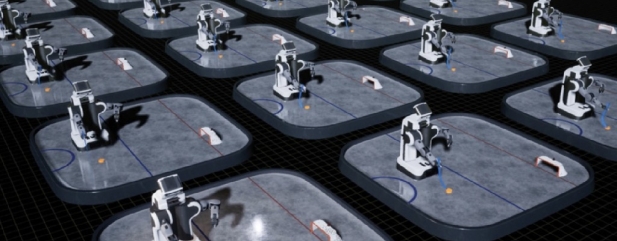Archived article
Please note that tax, investment, pension and ISA rules can change and the information and any views contained in this article may now be inaccurate.
Using ETFs to play the thriving robotics theme

Last month’s Goodwood Festival of Speed saw the unveiling of Europe’s first roadworthy autonomous delivery vehicle. Called Kar-go, the self-driving electric-powered robot on wheels has been developed by former Formula 1 and classic car boffins. It promises to slash the cost of last-mile goods delivery by up to 90%.
This is just the sort of exciting project to have captured the imagination of investors, fuelling the idea that disruptive technologies such as automation, robotics and artificial intelligence can transform industries and make investors a mint along the way.
Such innovation could mean streamlined production processes and 3D printed manufacturing, predictive analytics in retail and entertainment, and autonomous transport fleets speeding us home on networks of road and rail.
It is also why the Pictet Robotics (BDB6DB9) fund has grown into a whopping €4.72bn specialist vehicle in less than four years, and similar funds are emerging.
ETFS TO PLAY THE SPACE
Investors looking for a lower-cost way of playing this theme have several alternative options in the exchange-traded space. Among them is iShares IV Automation & Robotics ETF (RBOD) which tracks an index of developed and emerging market companies which are generating significant revenue from sectors associated with the development of robotic and automation technology.
It has 0.4% ongoing charges and provides exposure to such companies as US-based Inphi which produces semiconductor components; and Milacron, a manufacturer of plastic processing equipment which has just received a $2bn takeover offer from industrials group Hillenbrand.
Another route for investors is L&G ROBO Global Robotics & Automation ETF (ROBG) which tracks an 89-strong list of robotics and automation companies that must jump through some very demanding qualification hoops set down by the index provider’s team of tech industry experts and academics.
This was no easy task but ROBO has created a database of more than 1,000 companies across the globe, split into 12 sub-sectors of the robotics and automation theme, such as sensing, computer processing, logistics automation, energy and healthcare.
‘There is no perfect database of companies,’ admits Richard Lightbound, ROBO’s chief executive of the Europe, Middle East and Africa (EMEA) region, but he believes the ROBO index represents ‘established proven businesses’ with the products and technology capable of delivering high growth and returns potential for investors.
These are all companies trading on recognised global exchanges that derive most of their revenue from the wider robotics, automation and artificial intelligence (RAAI) sphere. This explains the glaring absence of some very well-known and large technology companies, such as Microsoft or Google, which have vast income streams outside the RAAI arena.
Potential index members are also judged on ESG (environmental, social and governance) criteria.
Beyond this point the index is split again. About 40% are established leading players whose core business is directly related to RAAI, what ROBO calls ‘bellwether’ companies, which can individually represent no more than 2% of the index.
These include Taiwanese motion controls designer Hiwin Technologies, which makes low-friction rails along which machinery can glide; and Flir, a US thermal imaging specialist.
The other 60% of constituents, or ‘non-bellwether stocks’, can account for no more than 1% of the index, being companies with a distinct portion of their business and revenue in RAAI and which have the potential to grow through innovation and market adoption of their products and services. To keep the balance honest ROBO modifies holdings on a quarterly basis.
GLOBAL SPREAD OF ASSETS
As you might expect, most of the companies tracked by the ETF are overseas-based, mainly in the US (45%) or from Japan (22%), with Germany (7%) and Taiwan (6%) following. The UK supplies just 3% of members, which amounts to grocery automation specialist Ocado (OCDO), robotic workforce designer Blue Prism (PRSM:AIM) and Renishaw (RSW), which designs and manufactures high tech measurement tools.
Perhaps the thing that makes the ROBO index stand out is its research team. It includes more than seven PhDs and some of the most highly respected robotic visionaries, working closely with management team to identify early key industry trends and associated companies.
They are active in their research efforts, regularly meeting company management teams, running adviser engagement meetings as well as the quantitative and qualitative number crunching you might expect.
‘If you compare our index with the iShares ETF, we have only about a 25% index overlap,’ says ROBO’s Lightbound. By that he means barely a quarter of the same companies will feature in both indices.
One reason, according to Lightbound, is that iShares’ research is predominantly based on financial data. Another is that the ROBO index includes a greater number of smaller companies. ‘We set a market cap floor at $200m,’ says Lightbound.
But if the proof of the pudding is in the eating, then the true measure of success for an ETF is performance, which has been pretty spectacular for the ROBO product, more than doubling since inception on 2 August 2013. Over the same period a FTSE 100-tracking ETF would have returned barely 15%.
We rate this ETF as a ‘buy’ with the caveat that performance could be quite volatile – i.e. the potential for wild swings in the share price – as many stocks it tracks are on expensive ratings and so the market will be less forgiving at the first sign of any bad news, or these companies quickly go out of favour when markets are in decline.
It is also twice as expensive as the iShares robotics ETF at 0.8%, albeit justified by having a more active approach when it comes to creating and managing the portfolio.
Important information:
These articles are provided by Shares magazine which is published by AJ Bell Media, a part of AJ Bell. Shares is not written by AJ Bell.
Shares is provided for your general information and use and is not a personal recommendation to invest. It is not intended to be relied upon by you in making or not making any investment decisions. The investments referred to in these articles will not be suitable for all investors. If in doubt please seek appropriate independent financial advice.
Investors acting on the information in these articles do so at their own risk and AJ Bell Media and its staff do not accept liability for losses suffered by investors as a result of their investment decisions.

 magazine
magazine










